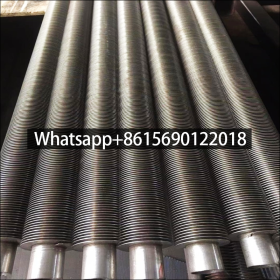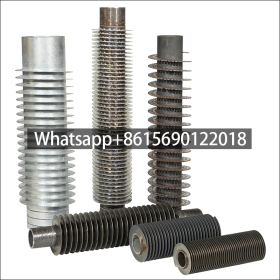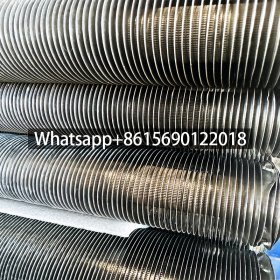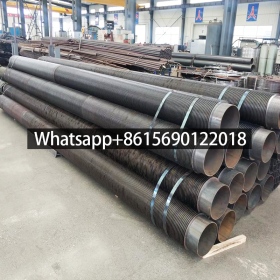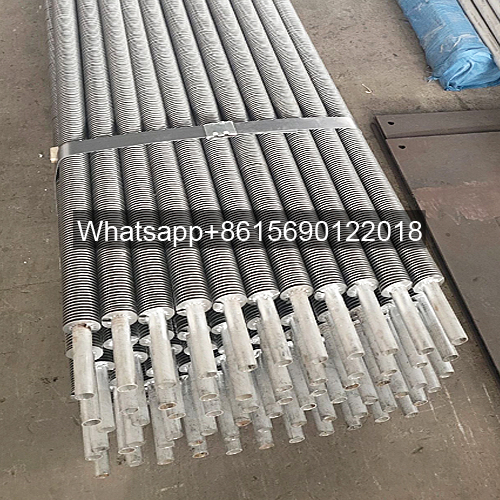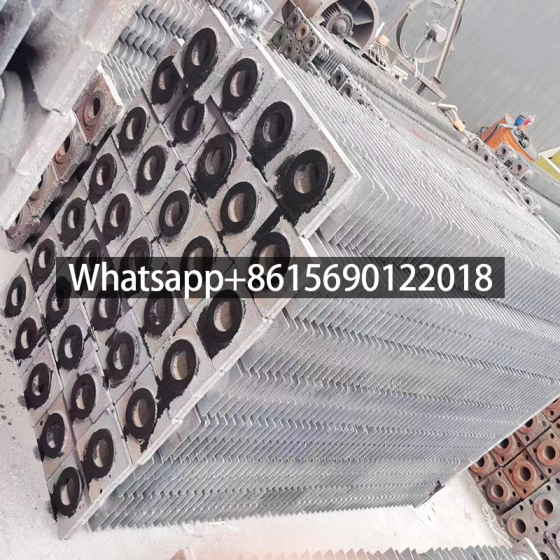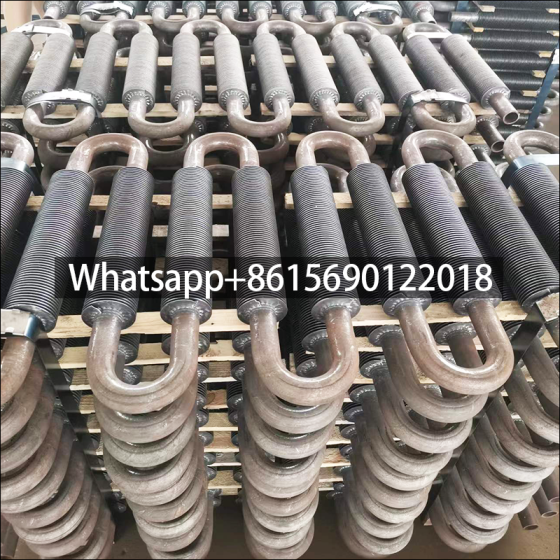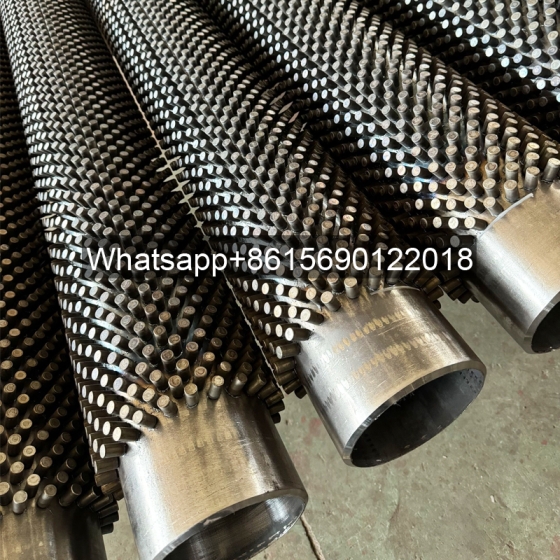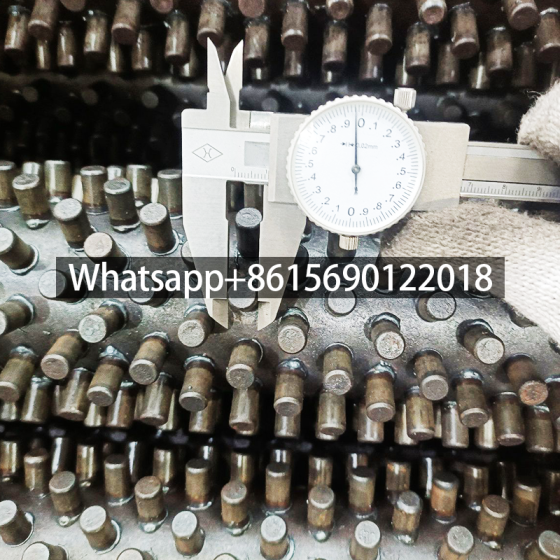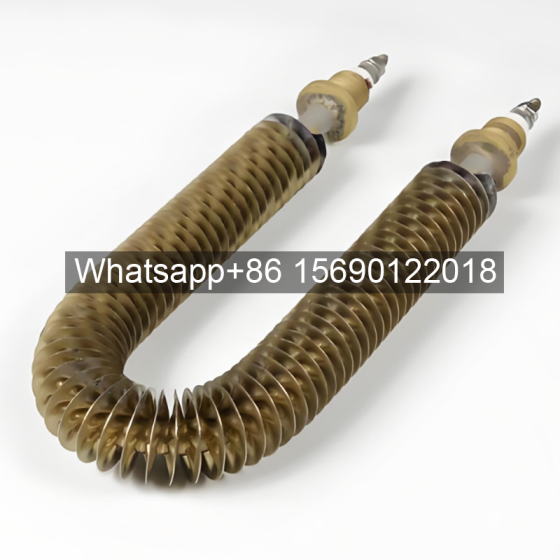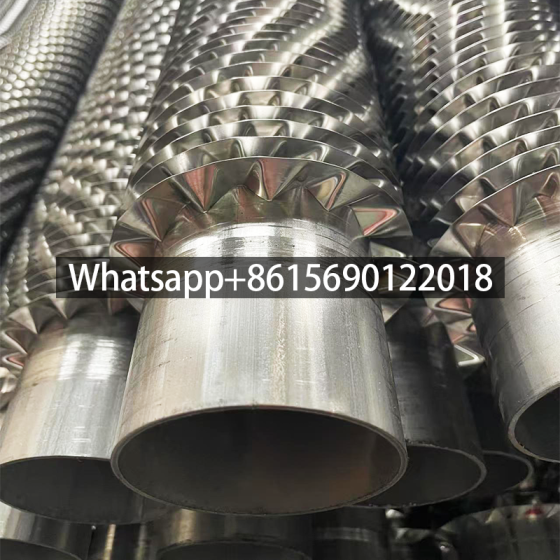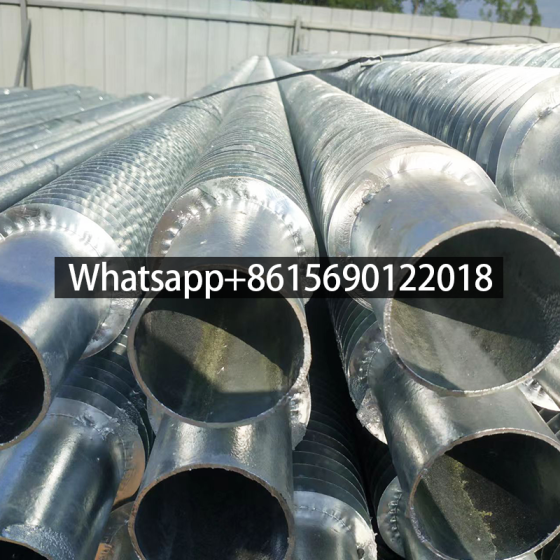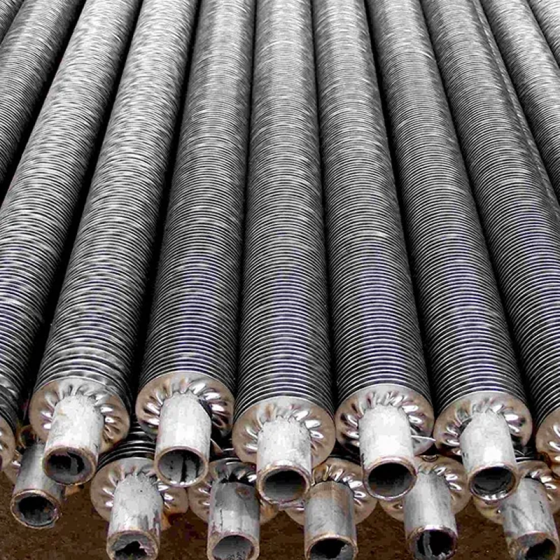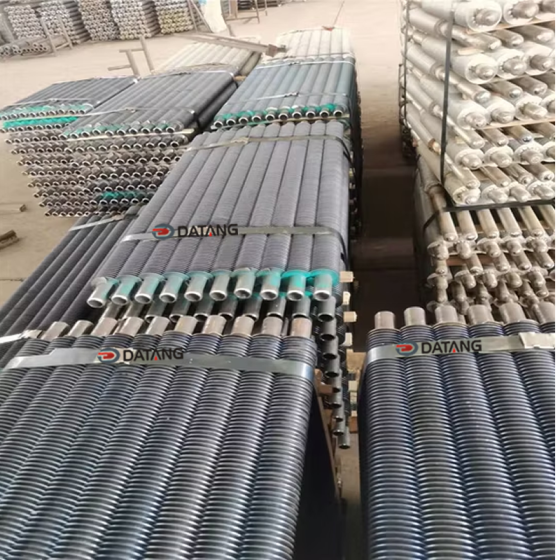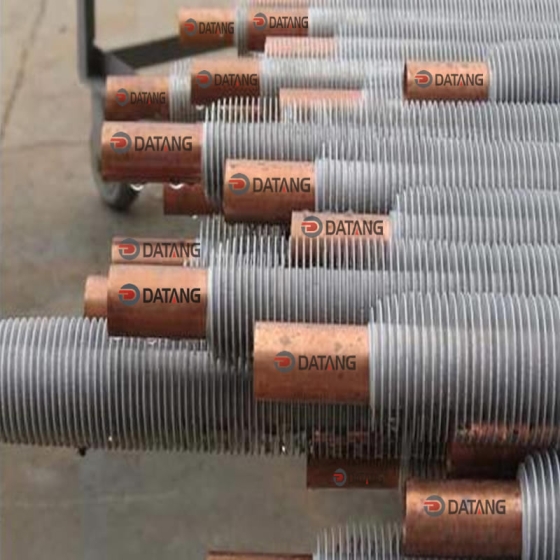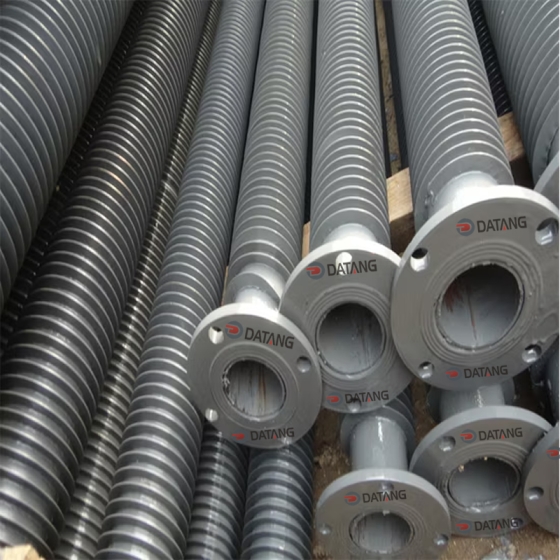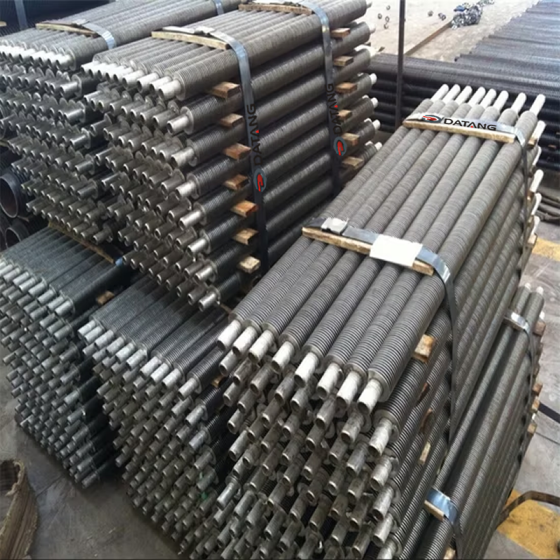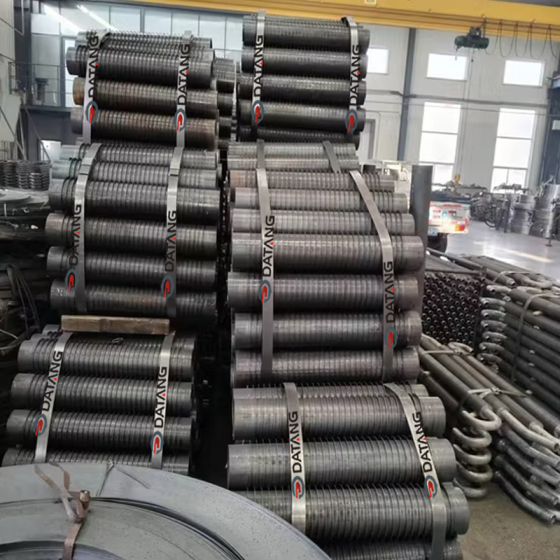Finned Tubes for Heat Exchangers
Finned tubes are the core enhanced heat transfer elements in heat exchangers. By adding fins to the base tube surface, they significantly expand the heat transfer area and improve thermal conductivity efficiency. Their structure, 製造プロセス, and application scenarios are detailed below:
? I. Fin Tubes for Heat Exchangers Working Principle & Structural Design
-
Enhanced Heat Transfer Mechanism
- Heat Conduction: Heat transfers from the hot fluid inside the tube (steam/high-temperature liquid) through the base tube (steel, stainless steel, etc.) to the tube wall, then diffuses via tightly bonded fins.
- Convective Heat Transfer: Fins disrupt the fluid boundary layer, increase turbulence, and enable cold fluids (e.g., air) to absorb heat efficiently. Fins can expand the heat transfer area by 3–10×, dramatically accelerating heat exchange.
- Phase-Change Heat Transfer (Steam Type): Steam condenses inside the base tube, releasing latent heat (1 kg steam releases 2,000–2,700 kJ), which transfers through fins to the heated medium (e.g., drying air).
-
Key Structural Elements
- Fin Shape: Circular fins reduce fluid resistance; square/rectangular fins enable dense arrangements; corrugated/serrated fins enhance turbulence.
- Arrangement: Staggered layouts improve heat transfer efficiency; in-line layouts reduce fluid resistance; cross patterns disturb flow; parallel layouts ensure uniform temperature.
- Base Tube-Fin Bonding: High-frequency welding achieves metallurgical bonding (near-zero thermal resistance); mechanical fitting is low-cost but has higher thermal resistance.
⚙️ II. Fin Tubes for Heat Exchangers Manufacturing Processes & Material Selection
-
Primary Manufacturing Processes
Process Type Characteristics Application Scenarios High-Frequency Welding Fins fuse with base tube; high bond strength; high automation High-temp/pressure (e.g., boilers) Integral Rolling Base tube and fins formed monolithically; seamless; corrosion-resistant Highly corrosive environments (chemical, marine) Mechanical Fitting Fins press-fitted onto base tube; low cost Low-budget or moderate heat transfer needs T-Shaped Finned Tube Spiral tunnels promote bubble nucleation; boiling efficiency ↑2–5× Reboilers, evaporators -
Material Compatibility
- Carbon Steel Finned Tubes: Low cost, high strength; suitable for high-temp non-corrosive environments (industrial heating).
- Stainless Steel Finned Tubes (304/316L): Resistant to chloride corrosion; used in food, pharma, desalination.
- Steel-Aluminum Composite Tubes: Steel tube withstands pressure + aluminum fins enhance conductivity; balances strength/efficiency (HVAC).
Datang Fin Tube Technical Parameters
| PRODUCT | TYPE | TUBE MATERIAL | FIN MATERIAL | TUBE SIZE | FIN SIZE |
| Heat Exchanger Finned Tube | Extruded Fin Tube | All Kind of Material can be applied | Aluminum A1100 | 15.88~50.8 | 7~11.5FPI |
| Fin Height Max 16mmH | |||||
| L-Foot Fin Tube | All Kind of Material can be applied | Copper C1100, C1220 | 12.70~50.8 | 7~11.5FPI | |
| (Wrap On Type) | Fin Height Max 16mmH | ||||
| G-Fin Tube (Embedded Type) | Aluminum A1100, A1050, A1060 | ||||
| High Frequency Welded Finned Tube | A179 Carbon Steel Tube | Carbon Steel Tube | 12.70~160 | 1.5~7FPI | |
| Stainless Steel Tube | Stainless Steel Tube | 0.8~3.2mm. Thickness | |||
| Alloy Steel Material | Alloy Steel Material | ||||
| Integral Copper & Copper Alloy High Finned Tube | C12200, C11000, C70600 | C12200, C11000, C70600 | 15.88~22.23 | 5~9FPI | |
| Max 12mm. H | |||||
| Oval Finned Tube | Carbon Steel Tube | Carbon Steel Tube | All Size Available | 5~15FPI | |
| Stainless Steel Tube | Stainless Steel Tube | ||||
| Alloy Steel Material | Alloy Steel Material | ||||
| Copper & Copper Alloy Tube | Copper & Copper Alloy Tube | ||||
| Monometallic Fin Tube | Low Fin Tube | Carbon Steel, stainless steel, titanium, 銅, brass, nickel alloy, 等. | — | 9.52~40 | 12, 16, 19 28 FPI, 等. |
| Turbo-C Tube | |||||
| Turbo-E Tube | |||||
| Corrugated Tube | All Kind of Material | — | 6.35~40 | 2~9FPI |
III. Fin Tubes for Heat Exchangers Applications & Industry Cases
-
Industrial Sector
- Energy/Power: Waste heat recovery from boiler flue gas (finned tube exchangers); lubrication oil cooling for turbines.
- Chemical/Metallurgy: Reactor temperature control (316L corrosion resistance); steel rolling cooling (Ni-based alloys for 800°C).
- Drying Systems: Steam-finned tubes for grain/timber drying; fin arrangement optimizes airflow.
-
Civil & Environmental Sector
- HVAC: Copper-aluminum finned tubes in fan coils; hydrophilic coatings reduce condensate.
- Transportation: Automotive radiators; marine engine cooling systems.
- Agricultural Greenhouses: Uniform heating; stainless steel resists humidity corrosion.
? IV. Fin Tubes for Heat Exchangers Selection & Performance Optimization
-
Key Parameters
- Fin Height/Spacing: Affects heat transfer area and anti-fouling capability (wider spacing for dusty chemical environments).
- Tube Bundle Arrangement: Staggered layouts ↑ efficiency by 20–30% vs. in-line but increase resistance.
- Condition Adaptation: High-temp/pressure → rolled fins; corrosive → stainless steel/zinc plating.
-
Emerging Technologies
- Material Innovation: Duplex stainless steels (high strength + corrosion resistance for petrochemicals).
- Structural Optimization: T-shaped fins ↑ boiling heat transfer; spiral fins enhance fluid disturbance.
Finned tubes drive continuous leaps in heat exchange efficiency through structural innovation and process refinement. Selection must balance operating pressure, media corrosivity, and thermal efficiency. Future advancements like high-entropy alloy fins and nanocoatings will extend their use in extreme environments.
 dtfinnedtube.com
dtfinnedtube.com


